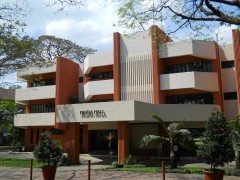DOST’s Expo Science 2011: “Nasa Siyensya ang Pag-ASA”, July 27-30, 2011, SMX Convention Center, Pasay City
July 8, 2011 10 Comments
Dear all,
We have 2 upcoming events where we have a booth to display what we
wish to make known about SOSE departments and projects:
B. DOST’s Expo Science 2011, with the theme “Nasa Siyensya ang Pag-ASA”, July 27-30, 2011, SMX Convention Center, Pasay City, 9 am to 6 pm.
1. We have 2 booths each with size 3m x 3 m. We need to provide
“interactive, interesting and enjoyable exhibits”. We can use the
same posters that you will send for NAST, but If you want to display
your interactive projects, you need to send at least 1 person every
day to run it.
2. We need 2 GA’s/TAs per day to man the booth. We will provide food
and transpo allowance. Please send me the names by July 20 of those
who are available on:
- July 27 (2)
- July 28 (2)
- July 29 (2)
- July 30 (2)
3. Please send your departmental brochures to give away.
If there are questions, please call me. Thanks.
marivi
SOSE Dean’s Office



why do we need this?
Reynaldo,
I think it is just a recognition that we haven’t tapped on science and technology for the economic growth of our country.
pinapagawa kami ni mr.matta ng essays,slogans,and posters about sa “nasa syensya ang pag-asa”,,,,,,can u help me?gusto kong makagawa kaso di me marunong!=0
Rodrigo,
If it is an essay, you may like to research (i.e., Google) to answer the following questions:
1. Name three countries that are exporting high technology products. What are these products? Describe them. What percentage of the countries’s GDP are technological products?
2. What does the government, business, and universities do in these countries to promote science and technology?
3. Name three high technology products that our country exports. Describe them and what they do. What percentage are these of our GDP?
4. What does our government, business, and universities do to promote science and technology?
5. What are your recommendations for our country to be competitive in science and technology?
If you just answer these questions with one paragraph each, you will already have a 5 paragraph essay. Of course, you can expand these paragraphs depending on the depth of your research.
what is this all about?nasa syensya ang pag asa? HOW CAN I USE THIS in my classroom?iam an elementary science teacher,,i want to have an interractive science classroom so teaching science wouldn’t be a boring subject and gives pressure to my pupils…that they have to remeber facts tahat are meaningless to them….i want my pupils make science learning enjoyable……and use in their lives….
Hi Miriam,
Maybe if we teach students the critical thinking in science and not just memorization of facts, then maybe someday they can use this mode of thinking to define our country’s problems, propose solutions, implement them, and move our country forward.
Science–biology, chemistry, or physics–is based on experiment. And an experiment has two facets: theoretical framework and methodology. If it is all theories and equations without experimental verification, it is useless. If it is all experiment without theoretical interpretation, it is also useless. Both theory and experiment must go hand in hand in order to teach students real scientific education.
Here are simple physics experiments for for grade school pupils:
1. Drop a chalk from different heights and determine when the chalk reaches the ground using stopwatch. If they graph the height vs time, they will get a parabolic curve.
2. Mark the shadow of the flagpole for different hours of the day. Are the location of the hours the same during week? during the month? during the year?
3. Measure temperature every hour from morning till night and plot the graph of temperature vs. time. Is the variation the same for the whole week? for the whole month? for the whole year?
4. If PAGASA announces that a storm is coming, install a wind vane to determine the direction of the wind. Get a barometer to measure air pressure. Let the students guess where the eye of the storm is and compare their answers to that of satellite images given by PAGASA. As a rule of thumb, the pressure drops near the eye of the storm (low pressure area) and the direction of the wind is perpendicular to the direction of the eye of the storm.
If you have other questions about physics teaching, just ask me in this blog.
Sincerely yours,
Dr. Quirino Sugon Jr.
Assistant Professor
Department of Physics
Ateneo de Manila Univesity
how to make slogan ?
Red,
What slogan on your mind? Something about science. Something that rhymes.
can you gave some example??
“nasa siyensya ang pagasa” is about science and it rhymes.